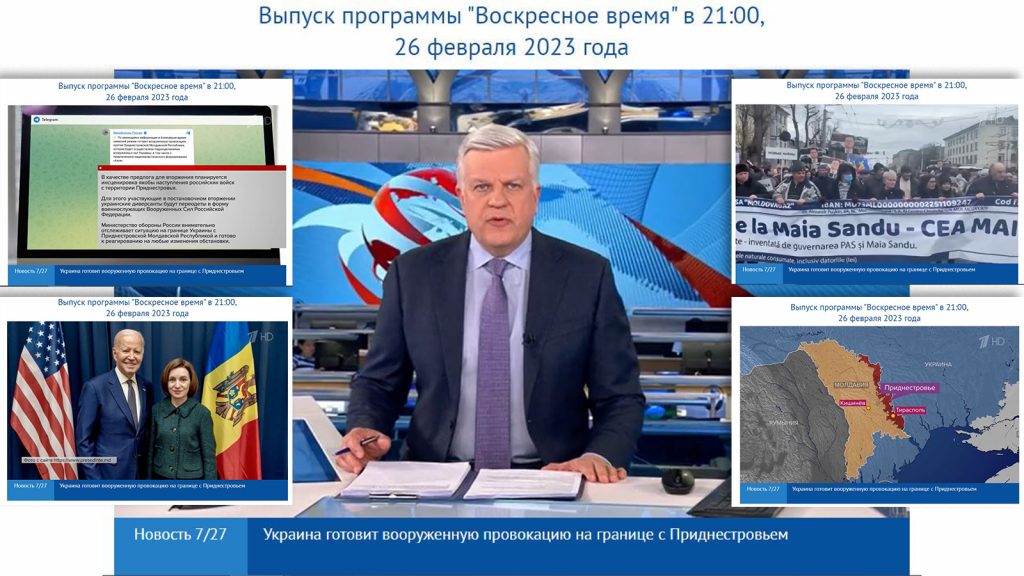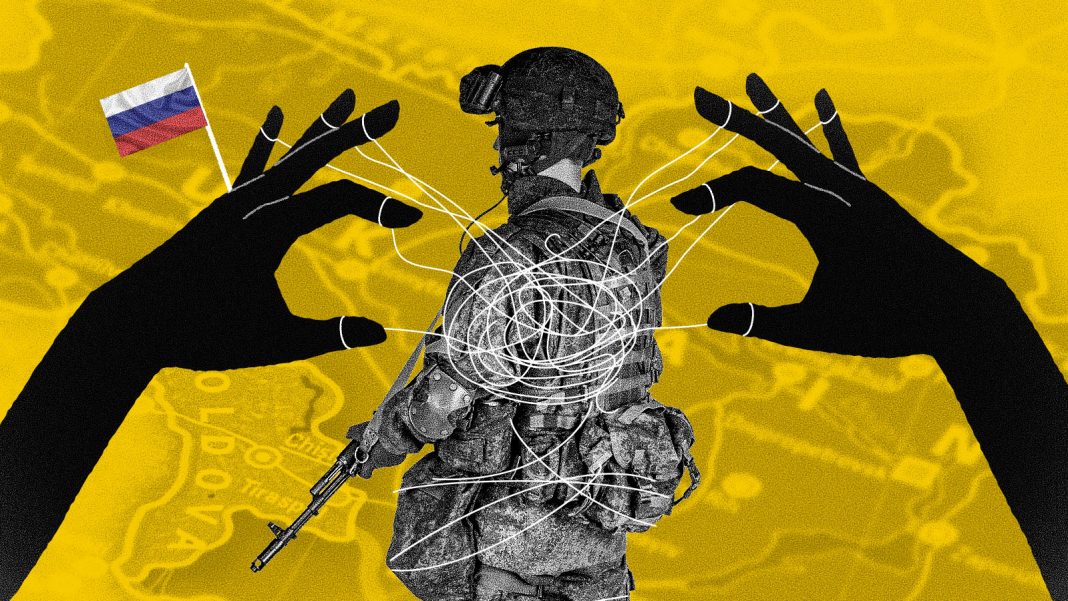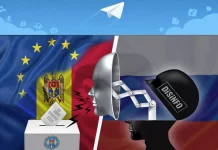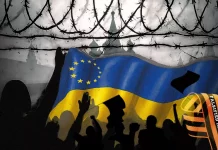Even if Russia’s military is fully occupied with its invasion of Ukraine, the Kremlin’s psychological warfare is still pressuring Moldova. Recent weeks have seen an escalation of Moscow’s manipulative allegations which involve claims that Ukraine will attack Transnistria, that Maia Sandu is plotting with Kyiv, and that, of course, the dark forces of the US and the West are pushing Chisinau into a conflict.
It all smells of yet another Russian attempt at psychological warfare against its neighbours. Possible goals include fostering instability, if possible, and diverting attention from the battlefield in Ukraine and from atrocious attacks on and deportations of civilians. The Kremlin’s accusations also come at a time when the Moldovan government has been taking steps to regain control of its information space. See our article here.
The Kremlin playbook
Russian state and pro-Kremlin outlets and proxies have increased the pressure on Moldova using almost everything in the playbook of classic information manipulation. Tactics include:
- Falsify: create a forged letter claiming to be from the Ukrainian armed forces ordering elements to prepare for an imminent invasion of Transnistria by Ukraine.
- Flood the information space: spread messages using as many platforms as possible with state outlets acting as beacons, first targeting audiences in Moldova through outlets known to be interacting with Russian narratives, and, at a later stage, through Russian state-affiliated media.
- Twist and misrepresent: turn a domestic political power transition and public demonstrations by the pro-Kremlin opposition to fit the narrative: Moldova in chaos, a puppet of the West, a population deceived by its government.
- Use of a political affiliate: high-profile propagandists like Vladimir Solovyov give a platform to former President Igor Dodon to fuel the fire.
- Finally, add a classic power-politics topping by strong-arming the legitimate President of Moldova, Maia Sandu, with a thinly veiled Russian threat: change your policy of Euro-Atlantic alignment or…
So far, this disinformation masquerading as ‘news’ has reached the key platforms of the Russian-speaking world and beyond, including Arab, Spanish, Italian, Georgian, and Armenian audiences targeted by pro-Kremlin sources. The flagship, Russian state TV Channel One Sunday 26 Feb.:

Setting the record straight – no Ukrainian invasion
Moldovan state authorities reacted to all these claims by denying the Russian Ministry of Defence’s manipulations, stressing it is in permanent contact with its partners, including Kyiv, and would immediately inform citizens of any emergency. The State Secretary of the Moldovan Ministry of Defence called Russia’s actions an ‘element of a psychological operation’ of the Russian war against Ukraine.
Mykhalo Podolyak, advisor to Ukrainian President Zelenskyy, urged people not to believe the Russian Ministry of Defence. According to him, Ukraine would never take actions in relation to Moldova without direct consultations with Chisinau and the countries of the European Union.
Launch a wild claim. Then repeat. Repeat. Repeat.
Director of the Moldova think-tank Watchdog.md, Valeriu Pasa, is convinced that the current actions are classical disinformation because they all started several days ago from an alleged Ukrainian Telegram channel.
On 21 February, the channel wrote that ‘almost 260 Ukrainian soldiers have been brought to the Transnistria section of the Ukrainian border’ and the alleged objective was to attack the region close to the village of Cobasna. There stands a huge ammunition depot that dates back to the times when Soviet forces were stationed in Transnistria. The post has more than 140,000 views.
Another Telegram channel called Typical Odessa shared the initial post, adding the claim that ‘there are NATO military personnel involved’.
Both posts and the Russian MoD release fit hand in glove with the now classic Moscow disinformation narrative alleging that the West is trying to drag Moldova into the war (see here, here and here).
How the Russian manipulation machinery works
On the morning of 23 February (in Russia the ‘Day of the Defender of the Motherland, in the USSR the ‘Day of the Soviet Army’), the Russian Ministry of Defence claimed that Ukraine is preparing provocations in the Transnistria region. The official press release, massively disseminated by Russian state and pro-Kremlin outlets (TASS, Vedomosti.ru, RIA, Interfax, etc.) spread many details about the alleged plans, including that Ukrainian soldiers wearing Russian military uniforms would simulate an attack on Ukraine.
Some websites and Telegram channels repeated the information and brought even more claims. For example, according to Segodnia.ru, Ukrainian Armed Forces are already at the border section amassing artillery, and the operation’s final objective is to capture the Cobasna ammunition depot.
The material was amplified by pro-Kremlin sources in Moldova, including the outlets Komsomolskaya Pravda Moldova (kp.md), Sputnik’s TG, and Smuglianka TG. Politicians favourable to Moscow joined in, especially former President Igor Dodon who suggested that Kyiv could have a plan to attack the Transnistria region. He wrote on his Facebook page that Moldova will solve the Transnistria conflict by itself, peacefully, and not the way Ukrainians allegedly want, ‘by force’.
In addition, Socialist MP Bogdat Tirdea wrote on his Telegram channel that Chisinau authorities ‘follow the Ukrainian scenario’, suggesting that Moldova is being dragged into the war. The Party of Socialists published an official statement demanding ‘peace guarantees’ for Moldova, giving credit to Moscow’s claims.
On 24 February, the Russian Ministry of Foreign Affairs issued a statement warning that any attack on the Russian military in Transnistria will be considered an attack on Russia.
Leaders in Tiraspol said they ‘are ready to deal with any provocations’ and if any danger appeared, they would warn people in advance.
On Sunday 26 February, a post on the @novorossia_region Telegram channel alleged that Ukraine is preparing to attack Transnistria. It included a picture of a supposed Ukrainian army document as evidence. The Telegram channel, created in 2021, has routinely promoted Russian narratives, especially regarding Kherson Oblast.
Within 50 minutes, the post and picture were reshared by News Front’s @newsfrontnotes and @golosmodora Telegram channels. After an hour, a message with the same picture and watermarked with Readovka’s logo was published on the @readovka Telegram channel and reshared, within ten minutes, by @bloknotmd, quickly generating over 600,000 views.
Ten minutes later, Vladimir Rogov’s @vrogov Telegram channel published another post including the same picture but watermarked with his own channel’s logo. Rogov, a Moscow puppet, is the so-called representative of the main council of the Zaporizhzhia region’s self-proclaimed military-civil administration. Simultaneously, the @izvestia_ru account published a tweet with a link to an article by the main Russian newspaper Izvestia. The tweet also quoted @vrogov’s Telegram message and included a picture of the document.
The post spread even further across both the Moldovan and Russian information spaces. Within one hour, an article including the picture was published on the News Front website. Three hours later, the @KpMoldova Telegram channel also posted the picture. Within five hours, a few articles not showing the document but quoting @vrogov as the source were published on Ukraina.ru, the Russian government newspaper rg.ru, the Russian state news platform RT (Russia Today), the Russian state main wire service RIA, and gazeta.ru.
On the Sunday evening of 26 February, the main Russian state TV evening news programme on Channel One gave the story a dramatic boost (see above screenshots). As we have analysed before, this disinformation vehicle alone reaches around 100 million Russian speakers and gets quoted on several other platforms.
1 March: One of the most prominent Kremlin propagandists propagandist Vladimir Solovyov, a host on Russian state platforms and TV programmes, claims that ‘Ukraine [is] plotting to attack’, citing former Moldovan President Igor Dodon’s Telegram account. During 1 March, Solovyov’s Telegram post jumps from around 80,000 to more than 240,000 views.
All these platforms are ‘blood veins’ to spread disinformation. Their material is quoted and reproduced exponentially, reaching millions of people and setting the agenda for discussion.
Smokescreen for a Russian plot to provoke a revolt in Moldova
Ukrainian President Volodymyr Zelenskyy affirmed at the beginning of February that Ukrainian intelligence intercepted a Russian plan to destabilise the political situation in Moldova. Several days later, Moldovan President Maia Sandu held an official briefing confirming that Kyiv provided information on the alleged Russian plan. She also asked law enforcement institutions to be vigilant.
According to Sandu, the Russian operation was to take place in the shadow of massive anti-government protests organised by the pro-Kremlin opposition. Violence against state institutions was part of the plan, with the help of provocateurs from Montenegro, Serbia, and Belarus.
On 21 February, newly appointed Moldovan Prime Minister Dorin Recean spoke about Moscow’s plans to take control of the Chisinau airport. The purported goal is to transport troops and ammunition through Transnistria in order to open a new front in Ukraine’s flank, the south-western region that includes Odesa and Mykolaiv. A successful operation would tie down forces that Kyiv very much needs on other fronts. See here, here.
In all these cases, Russia has denied any involvement, claiming that Ukraine is engaging in false flag operations against Transnistria.
The fear factor – but you are not alone
Whatever the outcome, Moscow activity in recent months illustrates its use of hybrid tools: economic pressure through gas exports, the use of Russian troops in Transnistria for local sabre-rattling, working with local political actors, and spreading lies and false rumours.
All this is done in such an obvious fashion that the plan is easily detected. But Moscow does not seem bothered to be considered a rogue bully as long as this perception creates fear among regional neighbours.
Ukraine has not bowed to Moscow’s brutal pressure. Moldova is calling out Moscow’s actions loud and clear. Earlier, Montenegro did the same, having discovered similarly sinister plans. If one message stands out, it is: raise the alarm when a bully plans to attack you. You don’t stand alone.





